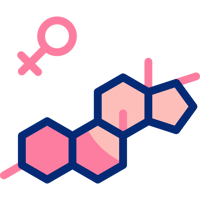Estrogen is one of the most important hormones in the human body, influencing everything from...
How to read the Gene page
Gene Information
Most genes have both a short name and a full name. For instance, the short name (or gene code) for a gene is CBS, while the full name is Cystathionine beta Synthase.
In the Gene Inspector, you can view both names at the top of the page, followed by a description of the gene's function.

To the right of the gene name, you'll find a link to the GeneCards website, which offers extensive information about the gene.
If available, the "Associated Pathology" section lists genetic diseases connected to gene dysfunction. This list does not imply that your genome is at risk for these diseases unless it has mutations that trigger them.
Gene Inspector does not provide a diagnosis based on your genome, even if the data suggests it; this is the responsibility of a licensed doctor.
Genetic disorders can have various inheritance patterns:
- Autosomal Recessive, where both alleles must have significant defects to cause the disease;
- Autosomal Dominant, where a mutation in one allele can lead to the disease, among other types.
Variants
Underneath the gene's general information, there is a tab displaying the Variants present in the genome you are examining.
These variants or mutations were identified following the sequencing or "digitization" of the genome.
Variants are categorized into different sections according to their effect on the genetic sequence and their frequency.
Minor Allele Frequency, expressed as a decimal between 0 and 1, indicates how often this variant appears in the population according to various studies.

In the screenshot above, the first variant lacks a known frequency (in the MAF column) and simultaneously alters the sequence in the "Promoter" region, thus it is categorized under "Rare, potentially important variants."
The second variant has a frequency (MAF) of 0.00311 and alters an amino acid in the resulting protein, classifying it as a missense variant with detailed information provided. It is also documented in the ClinVar database as a Variant of Unknown Significance (VUS) and "Likely Benign." Furthermore, this variant has a high REVEL score of 0.972, indicating a significant likelihood of affecting protein activity levels.
Details of Variants
Now let's review other pieces of information on the screenshot:
The orange line on the left and the orange circle with a lightning bolt indicate that a user has manually marked this mutation. You can also do this by clicking on the circle, which will display a plus icon inside.
Column "Type" indicates the variant type. "SNV" refers to a Single Nucleotide Variant, where the mutation alters just one "letter" in the DNA. Two other common types you might encounter are INS (Insertion) and DEL (Deletion).
Genotypes
The Genotype column displays specific DNA changes. A letter on a black background signifies that the allele is unmutated and matches the Reference Genome. Letters on a yellow or red/pink background indicate that one or both alleles have "letters" differing from the reference genome.

Reference SNP (rs ID)
The "rs ID" column lists one or more IDs from the DBSNP database, and you can click the link to access more details about the registered variant. Not all variants have an entry in this database, and very rare variants might lack such a record.
Details
The "Details" column provides crucial information about how the variant affects the gene.
There are various types of impacts, with the most common being "Intron," "Missense," effects on regulatory regions of the gene, "Frameshift," "Stop Gained," and "Stop Lost."
Additionally, some variants are evaluated using prediction algorithms like SIFT and Polyphen, which aim to determine whether the variant disrupts the normal function of the resulting protein.

